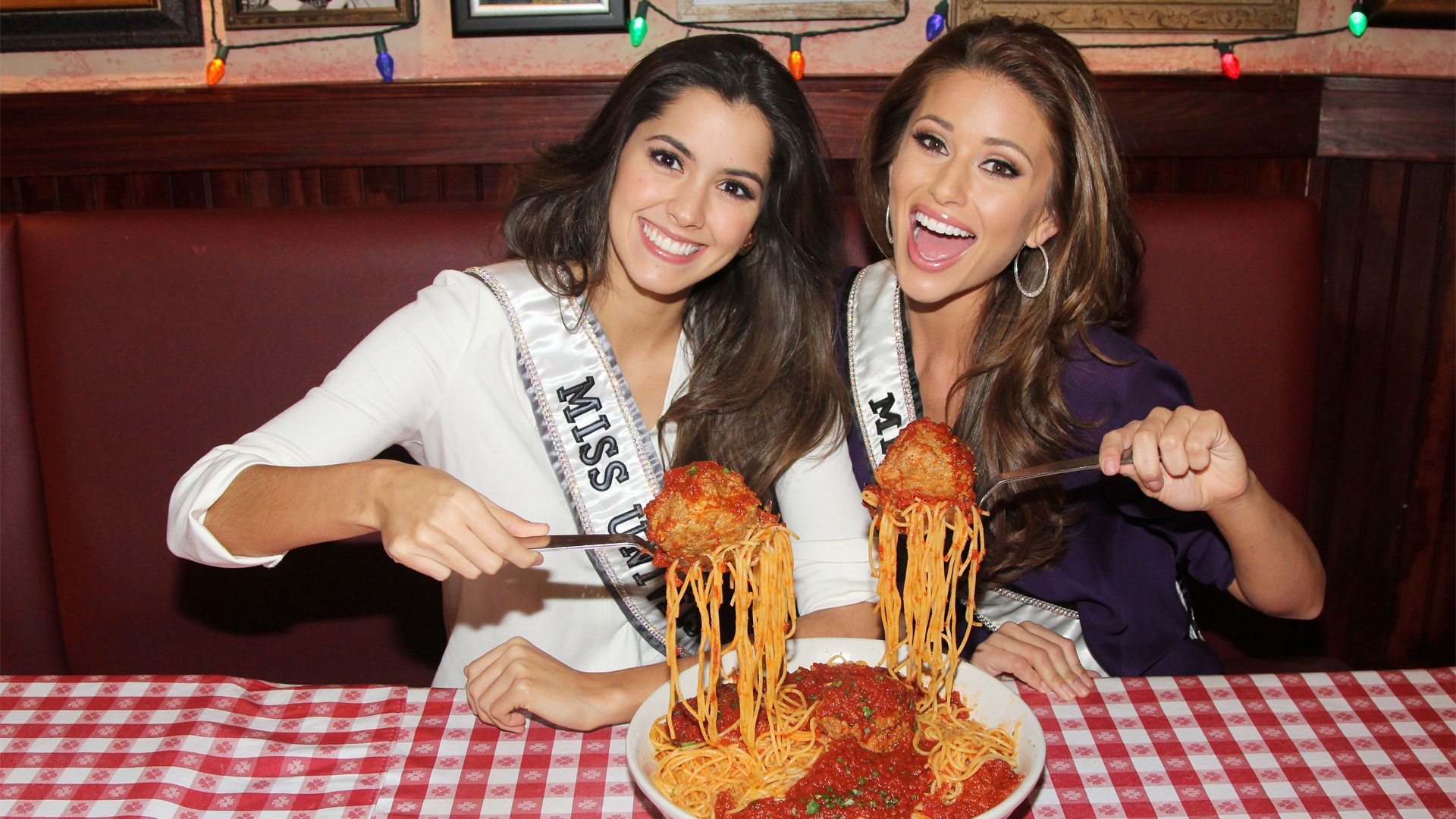In his new book, Red Sauce: How Italian Food Became American, Ian MacAllen cooks up a timeless American dish of spaghetti and meatballs.
No food symbolizes Italian American cuisine quite like spaghetti and meatballs, a dish celebrating the wealth immigrants found upon arriving in America, but also unheard of in Italian cuisine. During the great wave of migration, Italians left behind abject poverty in search of opportunity. Higher wages, the lower cost of food, and the greater quality of life they found in the United States allowed them to eat better, richer foods. Spaghetti and meatballs, like red sauce cuisine as a whole, evolved during the twentieth century from the abbondanza, the abundance, by combining the flavors and experiences of immigrants from southern Italy. The following excerpt from Red Sauce: How Italian Food Became American explores the evolution of the dish and the integration into mainstream American culture.
EXCERPT:
Meatballs are not just a symbol of Italian American cuisine but also a product of how Italians in America adapted. Southern Italians were long accustomed to finding ways of extending luxury foods like meat with lower-cost foods and food waste. In the case of meatballs, ground meat substitutes for expensive whole meat. Adulterating the meatballs with breadcrumbs not only helped bind the balls together but also reduced the cost of each ball by expanding the total volume. Breadcrumbs were commonly used in southern cooking to increase the calorie counts of an individual portion at a low cost. Nothing is more economical than finding a use for stale bread. Breadcrumbs found their way into all sorts of dishes and serve as a substitute for more expensive foods peasant farmers had little access to. For instance, some southern tomato ragù recipes call for adding breadcrumbs directly to the sauce. The starch thickens the sauce and adds volume to what might otherwise have been a lean meal. Vegetables are mixed with breadcrumbs browned in oil, and even pasta is topped with breadcrumbs instead of cheese. Meatballs are no different in this regard, with the bread adding volume to otherwise-expensive meat. Red sauce, pasta, and meatballs was a means to feed a large family with limited resources.
The exact origins of spaghetti and meatballs as a combined, American dish are difficult to pinpoint. For holidays and celebrations, meatballs were braised alongside sausages and veal shanks. Similarly, the Neapolitan lasagna di carnevale, a single-plate dish served on Fat Tuesday leading into the Lenten fast, contains small meatballs alongside sausages and other foods prohibited during Lent. These meatballs are smaller in size than those served with spaghetti and meatballs but show a tradition of mixing meatballs with sausages. Artusi offers a meatball recipe using boiled meat and gruel of milk and bread, flavored with raisins and pine nuts. These meatballs should be the size of eggs—not all that different than the typical American meatball—but are fried off and served alone rather than with spaghetti or tomato sauce.
An early recipe in The South Bend Tribune describes a casserole featuring meatballs of Hamburg steak. The steak is chopped up and combined with breadcrumbs, egg, onion, salt, and paprika, formed into balls, and fried before adding tomatoes, green pepper, onion, and butter and baked in a casserole dish. After forty-five minutes of baking, boiled spaghetti is added into the sauce along with some cheese, and the casserole is baked again. Although this recipe has some commonalities with red sauce spaghetti and meatballs, the second baking of the casserole distinguishes it as more of a distant cousin. Variations of spaghetti and meatball recipes had been circulating in newspapers as far west as Chicago in the early 1900s, when American canning companies like Heinz and Campbells wanted markets for their tomato products.
By the 1920s, spaghetti and meatballs had a fateful meeting. The New Macaroni Journal, the trade publication for macaroni manufacturers, published an article revealing Rudy Valentino’s favorite recipes. An Italian actor based in the United States, Valentino was a silent film star and a sex symbol of the 1920s before dying prematurely at the age of thirty-one. The New Macaroni Journal is not necessarily reliable as a factual account—they are the same publication responsible for spreading the myth that Marco Polo brought spaghetti back from China. But the publication did claim to publish two of Valentino’s favorite recipes, one for spaghetti with tomato sauce and another for meatballs. The spaghetti a la Valentino recipe includes a not-very-memorable tomato sauce, a basic recipe common for the time, but immediately following this recipe was one for Valentino’s favorite meatballs. Valentino’s “Savory Meat Balls” recipe includes a serving suggestion of plating alongside fried potatoes. The inclusion of a starch other than pasta suggests these meatballs are intended as a side dish, or perhaps a separate meal entirely. The recipe never mentions combining the meat with tomato sauce and pasta. The invention of spaghetti and meatballs could be attributed entirely to a misreading of the magazine’s article, and the American public’s adoration of celebrities.
1. Marlena Spieler, A Taste of Naples: Neapolitan Culture, Cuisine, and Cooking (Lanham, MD: Rowman & Littlefield, 2018), 170.
2. Alice Gitchell Kirk, “Domestic Science,” South Bend Tribune, April 9, 1913, 18, www.newspapers.com/image/514067995.
Around the same time, spaghetti and meatballs appears in an advertisement for American Beauty macaroni. The recipe calls for combining ground beef and pork, onion, bread, egg, parsley, and grated onions, formed into balls, and fried. Unlike the earlier meatball casserole, the American Beauty recipe suggests serving with pasta and tomato sauce together on a plate without baking the dish together. There is also a helpful image of a plate of spaghetti with two meatballs and portion of sauce on top—just as might be expected today. American Beauty wanted to sell macaroni, and there are few better ways to sell it than as the base to an affordable meat dish.
…
Spaghetti and meatballs with tomato sauce was entrenched in red sauce cuisine by the Depression era. Recipes began appearing in American cookbooks designed to appeal to mainstream American readers. It was during this period that Ettore Boiardi’s Chef Boyardee, known for spaghetti and meatballs, began offering cost-effective, pre-packaged canned pasta meals on grocery store shelves. Boiardi provided a line of canned ethnic food products, including everything diners needed like Italian cheese. Chef Boyardee had taken staples of red sauce cuisine and condensed them (both literally and metaphorically) into cans for mass-market production. Product lines from Chef Boyardee helped develop spaghetti and meatballs into an American food, and by the onset of World War II, Boyardee was positioned to sell canned spaghetti products to the military.
More indicative of the special position spaghetti and meatballs achieved, the U.S. Army included a recipe for spaghetti and meatballs with tomato sauce in their army manuals for the Second World War. The military cook- books provided large-scale recipes for feeding a hundred people at a time all while drawing from a standard commissary. The army’s spaghetti and meatball recipe was not a single recipe. The meatballs could be combined with other sauces such as brown gravy, with one serving option combining the meatballs with tomato sauce and spaghetti. The army’s recipes also adapted to available ingredients, with instructions for both ground meat and whole animal carcasses. The tomato sauce called for a single clove of garlic for six quarts of tomatoes, and that one clove was meant for a serving portion of one hundred. The tomato sauce included cinnamon, cloves, and cayenne; the pasta was to be cooked until soft and then braised in the tomato sauce, along with the meatballs, for thirty minutes, further softening the already-limp macaroni.
The mere inclusion of spaghetti and meatballs shows just how far Italian American ethnic cuisine had traveled by World War II. The only other ethnic foods in the manual are two Chinese American–style noodle dishes. The army’s version of spaghetti and meatballs, designed to appeal to soldiers from a wide spectrum of backgrounds, and limiting strong flavors like garlic helped shape a generation’s palate but also drove the American demand for red sauce cuisine in the years after the war, even if it was as processed, Americanized food. Spaghetti and meatballs became so ingrained in the American consciousness by the postwar period that the famous spaghetti eating scene in the 1955 Lady and the Tramp includes meatballs amid the spaghetti strings, a departure from depictions of spaghetti in films just a few decades earlier.
The evolution of Italian tomato ragù in the United States followed the immigrants’ pursuit of a more luxurious life. They replicated where they could and improvised when they couldn’t, but ultimately the resulting dishes are the product of a once-poor people growing richer and imitating wealth as they perceived it.
3. “Test Macaroni Recipes,” New Macaroni Journal, October 15, 1922, 38.
4. American Beauty Macaroni Products, “Meatballs and Spaghetti,” The Daily Sentinel (Grand Junction, Colorado), October 19, 1923, 12, https://newscomwc .newspapers.com/image/535895823.
5. Fabio Parasecoli, Al Dente: A History of Food in Italy (London: Reaktion Books, 2014), 234.
6. War Department. Army Recipes: War Department Technical Manual TM 10-412 (Washington, DC: U.S. Government Printing Office, 1944), 99.

